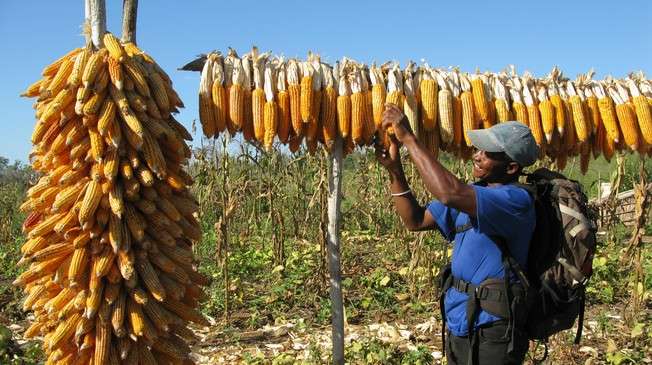Using compost to preserve forests in Madagascar

Research by an EPFL PhD student has found a way to boost Madagascar's corn crop yields up to five times while decreasing deforestation at the same time.
As part of her PhD research at EPFL's Ecological Systems Laboratory (ECOS), Justine Gay-des-Combes discovered a sustainable method for improving the slash-and-burn farming practices traditionally used in Madagascar, whereby a wooded area is burned to create a field for growing crops. Slash-and-burn farming also plays a role in the island's deforestation.
Gay-des-Combes, an environmental engineering student, spent two years conducting tests in two villages in the southwest of the country. The fruit of her labors is a socially responsible and environmentally friendly system that involves generating compost and refurbishing water wells; she also set up training sessions for local farmers on how to use her method.
"Slash-and-burn farming is deeply ingrained in Madagascan culture, so I decided to respect this traditional method while making it more sustainable," says Gay-des-Combes. During her project, she took measurements in corn crops, performed tests in new fields, and carried out carefully controlled experiments in pots.
Farmers using the ancestral method burn entire swaths of old-growth forests – and sometimes second-growth forests – and spread the ashes on the ground as fertilizer. To test her research hypothesis, Gay-des-Combes selectively cut down trees in second-growth forests instead of burning them completely and placed some compost around the corn seeds that were planted in areas where ashes had been spread using the traditional method. The tests were carried out on soil that was no longer considered fertile in order to determine whether effective synergies existed between the ashes and compost.
Building on a little-known method
After developing and testing her method in 2014 and 2015, she was able to boost crop yields by a factor of five relative to traditional farming methods. The corn she planted grew to be 240 cm tall versus 140 cm with the traditional method, and the harvest had more and better-quality ears. Her crop yields might have been even higher if it wasn't for a cyclone that hit the island in 2015.
"Not many farmers know about combining ashes and compost," says Gay-des-Combes. "Some of them think the ashes will burn the compost, but in fact, the ashes raise the soil's pH to neutral, which is good for tropical regions like Madagascar where the soil is highly acidic. The ashes also help release phosphorus and other nutrients that are important for plants. And the compost provides the organic matter and nitrogen that are missing in both the barren soil and the ashes – that also helps keep moisture in the soil. This method not only makes the soil more fertile, it also makes farming it more sustainable."
Because Madagascan farmers didn't have enough household waste to create the necessary amount of compost, Gay-des-Combes decided to make it out of branches from nearby trees that had been left unused. "We cut the branches into tiny pieces using a machete and a woodchipper, and then we put the pieces into one-meter-deep pits. We stirred the mixtures once a week and controlled the moisture level in the pits. Seven to eight months later, the compost was ready."
Wells and training
Another challenge was finding the water needed to maintain the compost. Gay-des-Combes created a non-profit organization called Blue for Green and through it raised funds with the help of EPFL's engineering student association Ingénieurs du Monde, of which she is a member and former president. She also got help from the Vaud Cooperation Federation (Fedevaco) to refurbish four wells and build a new one.
"The wells serve two purposes: they let us maintain the compost, and they provide a source of drinking water near the villages," says Gay-des-Combes. "We work with four instructors who maintain the wells, teach our farming methods to local farmers, and give advice on healthcare and hygiene. Half of the five hundred farmers who were trained have already tried our method of creating compost in pits. But it was hard to get them to understand the importance of regularly watering the 35 pits during a drought, when they already had to wait in line at wells to get water for their own use. So we are developing an automatic watering method to make it easier for them."
Resisting cyclones
One section of Gay-des-Combes' thesis discusses the effect that cyclones have on crops in Madagascar, comparing the 2015 cyclone season with a typical year. Crop yields drop by 75 percent after a cyclone, an increasingly frequent occurrence due to global warming. But adding compost to fields and leaving some trees standing – as is done in agroforestry – can prevent soil erosion and leaching by maintaining the ground's structure and retaining some of the soil's nutrients.
Gay-des-Combes' thesis supervisor is Alexandre Buttler, Director of ECOS; he has been performing research in Madagascar for over a decade. He believes her work will open new horizons: "The ultimate goal of our research at EPFL is to give farmers a way to plant the same soil year after year instead of using old-growth forests as a source of soil. Justine's thesis gives us some promising leads in the effort to improve crop yields and soil sustainability in one of the poorest regions in the world."
More information: Justine Gay-des-Combes, "Improving slash-and-burn agriculture in Central Menabe," Madagascar, 30 June 2017.
Provided by Ecole Polytechnique Federale de Lausanne





















